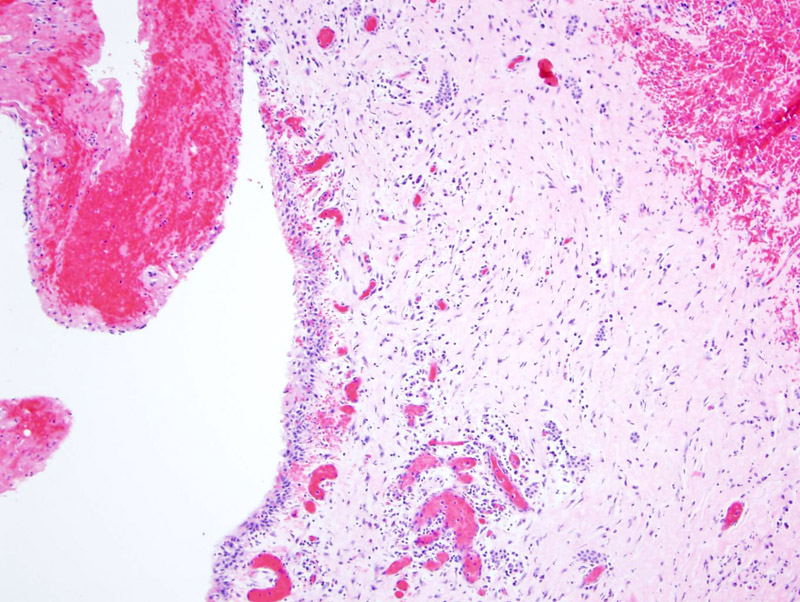

The cyst wall has a basaloid lining as well as a loose layer resembling stellate reticulum.
The fibrous wall has a lining of odontogenic epithelium with columnar or cuboidal basal cells as well as loose stellate reticulum-like cells.
The basal cells resemble ameloblasts and may form cords or single cells in the fibrous wall.
Dystrophic calcification and ghost cells are key distinguishing features of this entity.
Ghost cells appear to involve the entire epithelial lining in some areas.
Hyalinized eosinophilic material, suggestive of immature or dysplastic dentin, is closely associated with the epithelial lining. This material may be difficult to distinguish from ghost cells.
Calcifying cystic odontogenic tumor (CCOT), also known as calcifying odontogenic cyst or Gorlin cysts, is considered by some to be a development cyst with potential aggressive behavior; however, the WHO has categorized CCOT under "Odontogenic tumors" rather than "Odontogenic cysts".
This is a very rare entity, comprising 1-2% of all odontogenic cysts (Rajkumar, Slootweg).
To distinguish between the cystic form and the solid, more aggressive form, the term "dentinogenic ghost cell tumor" is used for the solid variant. The cystic variant comprises approximately 90% of cases, the the solid variant approximately 10% (Rajkumar)..
Histologically, the cystic form is characterized by an epithelial lining composed of an outer basaloid layer and an inner layer of resembling stellate reticulate that undergoes "ghost cell" keratinzation and dystrophic calcifications. There may be a foreign-body reaction to the cyst, and as such, this tumor resembles a pilomatrixoma of the skin (calcifying epithelioma of Malherbe).
CCOTs are usually intraosseous, but a subset can be peripheral or extraosseous. There is equal frequency in the mandible and maxilla. The lesion is generally slow growing and asymptomatic. Sometimes there is pain, root resorption and displacement of teeth.
Radiographically: Well-defined initially but can vary to ill-defined and irregular. It can be unilocular or rarely multilocular. It can be either completely radiolucent or with scattered calcifications when the lesion matures giving it a “salt and pepper” radiographic appearance.
→Although some thought this was a development cyst, it is now considered a neoplasm.
→The solid variant is more aggressive and has a different name - dentinogenic ghost cell tumor or odontogenic ghost cell tumor.
→Histologically similar to pilomatrixoma of skin, with ghost cells, dystrophic calcifications and sometimes surrounded by a foreign body reaction to the cyst.
Rajkumar K, Kamal K, Sathish MR, Leena S. Calcifying odontogenic cyst. J Oral Maxillofac Pathol 2004;8:99-103
Regezi JA. Odontogenic Cysts, Odontogenic Tumors, Fibroosseous, and Giant Cell Lesions of the Jaws. Mod Pathol 2002;15(3):331-341.
Slootweg PJ. Lesions of the Jaw. Histopathology 2009, 54, 401-418.